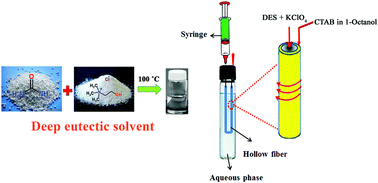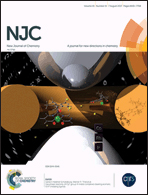Deep eutectic liquid organic salt as a new solvent for carrier-mediated hollow fiber liquid phase microextraction of lead from whole blood followed by electrothermal atomic absorption spectrometry†
Abstract
In the present work, for the first time, a new carrier-mediated hollow fiber liquid phase microextraction (CM-HFLPME) technique was applied for the determination of lead in whole blood samples by means of ETAAS. Lead was extracted from 17 mL of an acidic sample solution into 1-octanol containing N,N,N-cetyltrimethyl ammonium bromide (CTAB) and finally back-extracted into 25 μL of deep eutectic solvent (DES) containing KClO4 as the receiving phase. The effects of different variables on the extraction efficiency were considered using a central composite design. Under the optimized conditions, a preconcentration factor of 33 was obtained. The LOD and LOQ were found to be 0.1 and 0.4 ng mL−1, respectively. The calibration curve was linear within the range of 1–200 ng mL−1 (r2 > 0.9915). RSD% values (n = 3) of 4.4% and 2.3% were obtained at the concentrations of 5.0 and 20 ng mL−1, respectively. Finally, the obtained results for lead contents in two control and test whole blood samples were compared with the lead content of opium samples to investigate the correlation between them.



 Please wait while we load your content...
Please wait while we load your content...